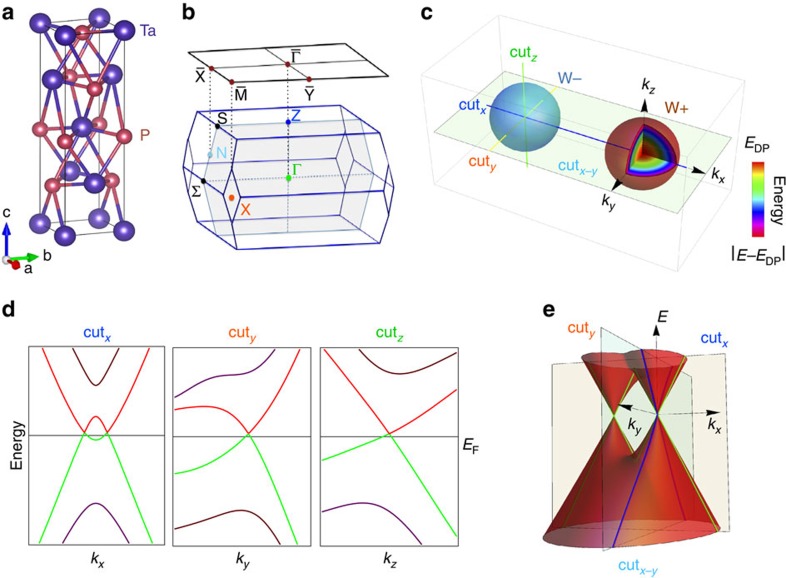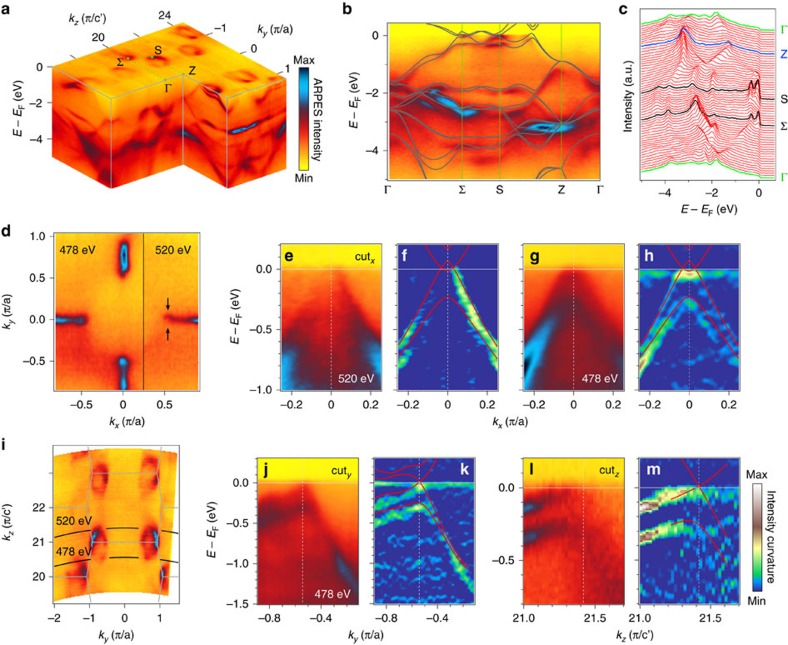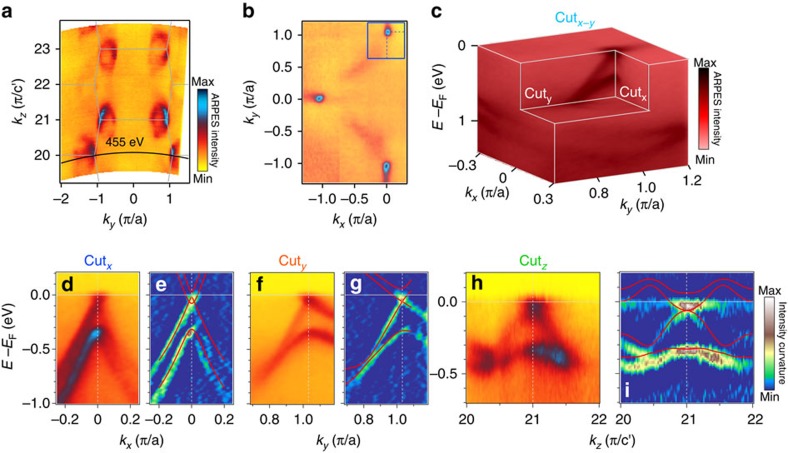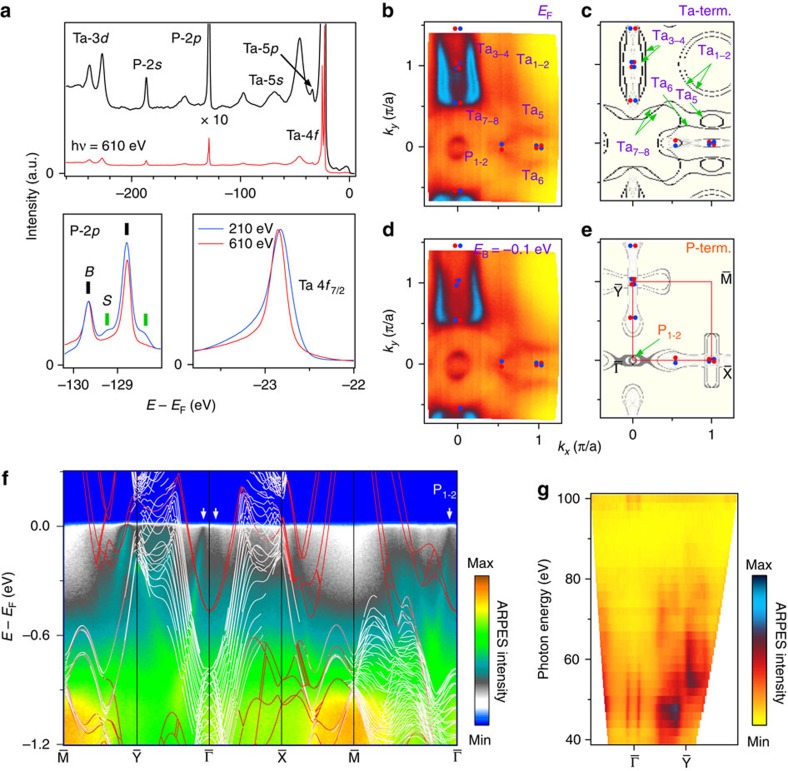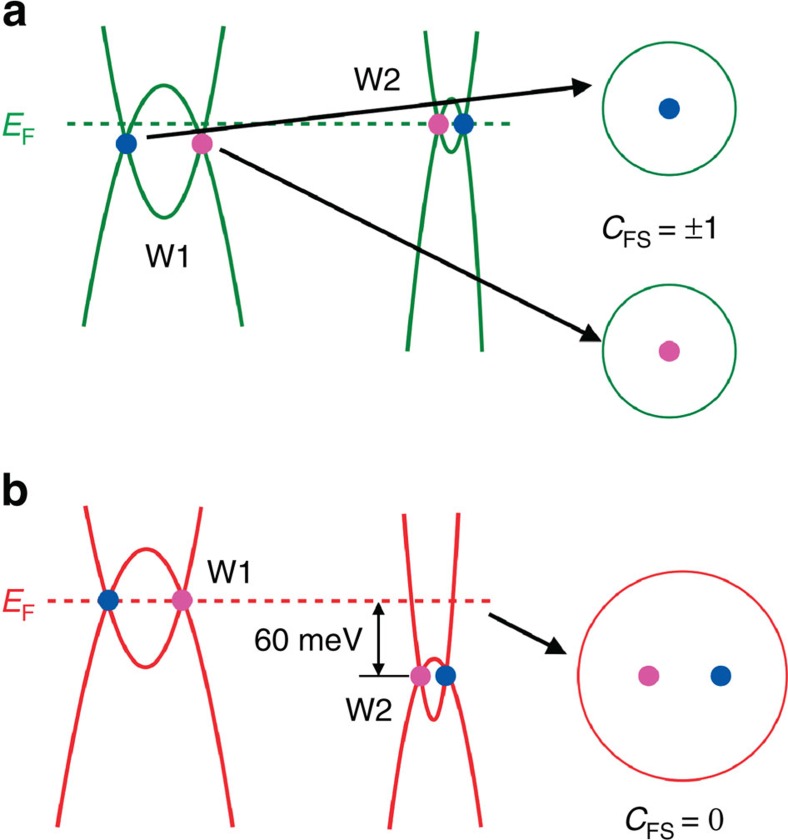Abstract
A Weyl semimetal possesses spin-polarized band-crossings, called Weyl nodes, connected by topological surface arcs. The low-energy excitations near the crossing points behave the same as massless Weyl fermions, leading to exotic properties like chiral anomaly. To have the transport properties dominated by Weyl fermions, Weyl nodes need to locate nearly at the chemical potential and enclosed by pairs of individual Fermi surfaces with non-zero Fermi Chern numbers. Combining angle-resolved photoemission spectroscopy and first-principles calculation, here we show that TaP is a Weyl semimetal with only a single type of Weyl fermions, topologically distinguished from TaAs where two types of Weyl fermions contribute to the low-energy physical properties. The simple Weyl fermions in TaP are not only of fundamental interests but also of great potential for future applications. Fermi arcs on the Ta-terminated surface are observed, which appear in a different pattern from that on the As-termination in TaAs and NbAs.
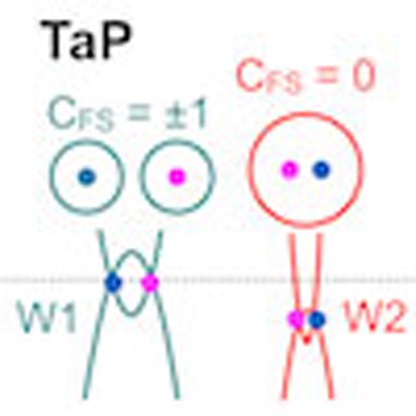 Weyl semimetals exhibit exotic properties owing to the presence of Weyl fermions. Here, Xu et al. show that tantalum phosphide is an ideal platform for studying the transport properties of these particles because its low-energy properties are dominated by a single type of Weyl fermion.
Weyl semimetals exhibit exotic properties owing to the presence of Weyl fermions. Here, Xu et al. show that tantalum phosphide is an ideal platform for studying the transport properties of these particles because its low-energy properties are dominated by a single type of Weyl fermion.
The Weyl semimetal (WSM) has recently attracted great attentions as a novel quantum state in which spin non-degenerate band crossings near the chemical potential are topologically unavoidable1,2. The band crossing points, called Weyl nodes, always appear in pairs with opposite chirality and the bands near the Weyl nodes disperse linearly in three-dimensional (3D) momentum space that can be described by reduced two-component massless Dirac equations3. An isolated Weyl node is a sink or a source of Berry curvature whose chirality corresponds to a topological charge4,5 and exhibits the chiral anomaly6,7,8 that can give rise to various exotic transport phenomena such as negative magnetoresistance (MR)7, non-local quantum oscillation9 and the quantum anomalous Hall effect5. In addition, the WSM hosts topologically non-trivial surface states forming arcs, so-called Fermi arcs, extending the classification of topological phases beyond insulators. The WSM state needs no additional symmetry protection other than translational symmetry in the crystal and therefore can be more robust than the other topological semimetal states in which additional crystal symmetry are needed10,11,12,13,14,15,16,17.
Various materials have been proposed as candidates for the WSM based on time-reversal symmetry breaking1,5,18, but the experimental realization remains doubtful19,20,21,22,23,24,25,26,27,28. Recently, the WSM based on inversion symmetry breaking has been predicted to be realized in nonmagnetic and non-centrosymmetric transition metal monoarsenides/monophosphides29,30, and indeed the key features of the WSM including the Fermi arcs31,32,33,34 and the Weyl nodes35 and the negative MR36,37,38 have been observed in TaAs. This monoarsenides/monophosphides family has two types of Weyl nodes: the W1 Weyl nodes in a pair well separated in momentum space off the kz=0 plane and the W2 Weyl nodes very close to each other in kz=0 plane. In TaAs, W1 and W2 are not related with each other by any symmetry, which makes W1 and W2 have a different velocity matrix and locate at a different energy level. However, the Fermi Chern number (CFS)10 (net topological charge enclosed by a Fermi surface) of a Fermi surface determines the low energy physical properties of WSM. In TaAs, each of the W1 and W2 Weyl nodes is enclosed by a single Fermi surface under experimental carrier density31,34,35,36. This makes the transport properties quite complex with mixed contributions from both the types of Weyl nodes.
The realization of WSMs with well-separated Weyl nodes of single type sitting at a chemical potential is crucial for clearly revealing the fundamental physics and practical applications of the novel WSM states as it is an ideal platform having the simplest Weyl nodes in WSMs21. A promising candidate is TaP in which a large and unsaturated negative MR has been observed39,40,41.
Here, we present the electronic structure of TaP demonstrating the complete feature of the WSM states. In the bulk, pairs of the W1 Weyl nodes well separated in momentum space have been found to locate at the chemical potential; whereas the poorly separated ones, that is, W2 are found to locate 60 meV below the chemical potential, with pairs of opposite chiral W2 enclosed by one Fermi surface. This leads to only a single-type Weyl fermions dominating the exotic low energy physical properties, such as observed magneto-transport phenomena and quantum oscillation. The Fermi arcs on the Ta-terminated surface have also been observed, with an entirely different pattern from that on the As-terminated surface observed in TaAs and NbAs31,32,33,34. Our results illustrate that the Fermi arc states strongly depend on the details of surface conditions, which has to be considered in the transport and spectroscopic properties of a system where surface contribution is non-neglectable, such as thin film and non-local quantum oscillations.
Results
Weyl semimetal state in TaP single crystal
TaP has a body-centred-tetragonal structure without inversion symmetry (space group I41md), depicted in Fig. 1a. The lattice parameters obtained from our X-ray diffraction measurement at room temperature are a=b=3.32 Å and c=11.34 Å (see Supplementary Fig. 1), consistent with a previous report42. An ab initio calculation predicts 12 pairs of the Weyl nodes in the Brillouin zone (BZ; Fig. 1b) where eight pairs locate at kz∼±0.6 π/c' (named W1) where c′=c/2 and the other four reside in the kz=0 plane (W2; ref. 16. Figure 1c illustrates the band structure near a pair of Weyl nodes where the colour of spheres represents the chirality. The energy bands near the Weyl nodes disperse linearly in all the directions in momentum space and satisfy the following conditions. (1) Along the cut passing through a pair of Weyl nodes (cutx in Fig. 1c), two spin non-degenerated bands cross each other twice and disperse linearly near the crossing points (Fig. 1d). (2) The band along a cut perpendicular to cutx (cuty or cutz in Fig. 1c) passes through one Weyl node and exhibits a single Dirac cone dispersion, seen in Fig. 1d. (3) The band in the kx-ky plane (cutx-y in Fig. 1c) containing a pair of the Weyl nodes has a double Dirac cone dispersion, as depicted in Fig. 1e.
Figure 1. Pairs of Weyl nodes in TaP.
(a) Crystal structure of TaP. (b) Bulk and surface BZ of TaP with high-symmetry points labelled. (c) Illustration of a pair of Weyl nodes in 3D momentum space. (d) Band structure passing through Weyl node along cutx, cuty and cutz. (e) Schematic band dispersions of a pair of Weyl nodes in the kx-ky plane of the momentum space.
Bulk electronic structure of TaP
The bulk electronic structure of TaP has been characterized by angle-resolved photoemission spectroscopy (ARPES) with photon energy in the soft X-ray region, which has high bulk sensitivity and kz resolution43,44. Figure 2a presents the ARPES spectra in the kx-kz plane (the shadow plane in Fig. 1b), acquired with hν=300–700 eV. Both the Fermi surface (FS) and the band disperses along kz show a periodicity of 2π/c′, indicating a bulk origin. The measured bands are in good agreement with the bulk band structure calculated with spin–orbit coupling, as shown in Fig. 2b. Owing to the absence of inversion symmetry and the strong spin–orbit coupling in TaP, the spin degeneracy is lifted and the bulk states split into two bands, which are clearly observed in the ARPES results and band calculations (Fig. 2b).
Figure 2. Bulk electronic structures and W1 type of Weyl cones in TaP.
(a) Photoemission intensity of the bulk electronic states as a function of energy relative to Fermi level in the ky-kz plane. (b,c) The ARPES spectrum and the energy distribution curves along the high-symmetry lines Γ-Σ-S-Z-Γ. The calculated bands are overlaid on top of the spectrum in b for comparison. (d) Fermi surface map in the kx-ky plane at kz=±0.58 π/c', taken with hv=478 and 520 eV. (e,f) ARPES intensity plot and its curvature plot with calculated bands overlaid on top. The data were acquired with hν=520 eV along cutx passing through W1. (g,h) Same as e and f, but the data were acquired with hν=478 eV. (i) Fermi surface map in the ky-kz plane at kx=0, the data were acquired with soft X-ray. (j,k) and (l,m) Same as g,h but along a long cuty and cutz, respectively.
Observation of Weyl nodes in TaP
With the above conditions, we have identified the Weyl nodes W1 and characterized them. Figure 2d shows that the FS splits into two small pockets sitting aside the kx/y=0 plane, which is fully consistent with the band structure of Weyl nodes (Fig. 1e). The ARPES intensities and the corresponding curvatures along cutx shown in Fig. 2e,f and Fig. 2g,h (for kz=±0.58 π/c′ as seen from Fig. 2i) display that two bands cross each other twice with the Weyl nodes at kx=±0.03 π/a, in good agreement with our calculation. The band bottom of the electron-like band is slightly below EF, which is enhanced with photons of 478 eV (Fig. 2g,h) due to the matrix element effect. The band structures along cuty/cutz exhibit the Weyl nodes locating at ky=0.54 π/a and kz=0.58 π/c′, also remarkably consistent with the calculation as seen in Fig. 2j–m. The band evolutions along ky/kz further verify the 3D nature of this double Dirac cone dispersion (see Supplementary Fig. 2). Within the experimental error, the Weyl nodes W1 locate at the chemical potential and the distance between the opposite chirality nodes in a pair is 0.06 π/a.
The other sort of nodes W2 locating at the kz=0 plane has also been identified. Figure 3b shows the FS map recorded at hν=455 eV corresponding to kz=0. Because the chemical potential is 60 meV above the Weyl nodes W2, the FS shows a single pocket at the middle points of the BZ boundary, in contrast to the FS of W1 that forms two small pockets slightly off the mirror plane. W2 residing below the chemical potential allow to us observe the whole band dispersion near the Weyl nodes, including the upper branches of Dirac cones. A double Dirac cone dispersion displaying in the band structures along the cutx and a single Dirac cone dispersion with a small Fermi velocity along the cuty and cutz are shown in Fig. 3c–i. The evolutions of the experimentally determined band structure along ky and kz directions (see Supplementary Fig. 3) further confirmed the Dirac cone dispersions in all the three directions of momentum space at the Weyl nodes W2. The full consistency between the experiments and the first-principles calculations unambiguously establishes the Weyl nodes W2 at (±0.01 π/a, ±1.03 π/a, 0) with a separation of 0.02 π/a in a pair. These clear show that every pair of W2 with opposite chirality or topological charge is enclosed by a single Fermi surface with a zero CFS (refs 10, 45), and such Fermi surface is topologically trivial and its low energy physics is not associated with Weyl fermions46.
Figure 3. W2 type of Weyl cones in TaP.
(a) Fermi surface map in the ky-kz plane at kx=0, acquired with soft X-ray. (b) Fermi surface map in the kx-ky plane at kz=0, taken with hv=455 eV as indicated in a. (c) ARPES intensity profile as a function of energy relative to Fermi level in the kx-ky plane containing a pair of Weyl nodes W2. (d) Photoemission intensity plot along cutx passing through W2. (e) The corresponding curvature plot of the spectrum in d with the calculated bands overlaid on top for comparison. (f,g) and (h,i), Same as d,e but along a long cuty and cutz, respectively.
Fermi arcs on Ta-terminated surface in TaP
The Fermi arcs appearing at the surface that connect the surface projections of the Weyl nodes in pairs are another key feature of the WSM, and induce exotic transport properties like non-local quantum oscillation. The surface sensitivity of ARPES with vacuum ultraviolet light enables us to distinguish the surface states from the bulk states. In Fig. 4a, comparison between angle-integrated core level spectra taken with soft X-ray and vacuum ultraviolet light reveals that Ta- and P-terminated surface states coexist; two additional P-2p peaks and the broadening and position change of the Ta-4f peak in the vacuum ultraviolet spectrum indicate the P-terminated surface states and Ta-terminated ones, respectively.
Figure 4. Fermi arc on the Ta-terminated (001) surface of TaP.
(a) Core level spectra taken with hν=610 eV, and comparisons to the one recorded with vacuum ultraviolet light for P-2p and Ta 4f7/2 core levels. (b) Fermi surface map recorded with vacuum ultraviolet light (hν=50 eV). (c) The calculated Fermi surface of the surface states on the Ta- terminated (001) surface. (d) ARPES intensity map at EB=−0.1 eV. (e) The calculated Fermi surface on P-termination (term.). (f) ARPES spectra along high symmetry lines acquired with hν=50 eV. The calculated bands on Ta termination are overlaid for comparison. The surface bands resulting from the Ta-terminated surface are indicated with colour lines. The grey arrows indicate the surface states from P-terminated surface. (g) Photon-energy-dependent spectrum acquired with hν=40–100 eV.
The FS and band structure measured at hν=50 eV well agree with the calculation of the surface states on the Ta-terminated (001) surface (Fig. 4b–f). Our calculation reveals that on the Ta-terminated surface along the  direction, the Fermi arcs between the pairs of W1 nodes are very short, thus it is difficult to resolve them. On the other hand, along the
direction, the Fermi arcs between the pairs of W1 nodes are very short, thus it is difficult to resolve them. On the other hand, along the  direction, the Fermi arcs connect the W1 nodes in adjacent BZs, marked as Ta3-4 (Fig. 4c). Consistent with the calculation (Fig. 4c), the FS map determined from ARPES measurements (Fig. 4b) clearly shows the Fermi arc Ta3-4 terminating at the projection of the W1 nodes at (0.03 π/a, 0.54 π/a) and (0.03 π/a, 1.46 π/a) on the surface. At a higher binding energy (EB=−0.1 eV), the end point of the Fermi arc Ta3-4 goes away from the Weyl nodes (Fig. 4d), consistent with the dispersion of the bulk Weyl cones. The intensity of the surface states associated to the P-terminated surface is weak and only two hole-like pockets centred at the
direction, the Fermi arcs connect the W1 nodes in adjacent BZs, marked as Ta3-4 (Fig. 4c). Consistent with the calculation (Fig. 4c), the FS map determined from ARPES measurements (Fig. 4b) clearly shows the Fermi arc Ta3-4 terminating at the projection of the W1 nodes at (0.03 π/a, 0.54 π/a) and (0.03 π/a, 1.46 π/a) on the surface. At a higher binding energy (EB=−0.1 eV), the end point of the Fermi arc Ta3-4 goes away from the Weyl nodes (Fig. 4d), consistent with the dispersion of the bulk Weyl cones. The intensity of the surface states associated to the P-terminated surface is weak and only two hole-like pockets centred at the  point (P1-2 in Fig. 4e) are visible in the FS map (Fig. 4b) and in the band structure (Fig. 4f, also see Supplementary Fig. 4). The data measured with vacuum ultraviolet lights have been confirmed to originate because the obtained FS does not change when varying the incident photon energy (Fig. 4g). The topology of the Ta-terminated Fermi arc states observed in TaP is totally different from the formerly reported As-terminated ones in TaAs and NbAs31,32,33,34. Our results illustrate that the Fermi arc states strongly depend on the details of surface conditions, which has to be considered for interpolating the transport and spectroscopic properties when surface contribution is non-neglectable.
point (P1-2 in Fig. 4e) are visible in the FS map (Fig. 4b) and in the band structure (Fig. 4f, also see Supplementary Fig. 4). The data measured with vacuum ultraviolet lights have been confirmed to originate because the obtained FS does not change when varying the incident photon energy (Fig. 4g). The topology of the Ta-terminated Fermi arc states observed in TaP is totally different from the formerly reported As-terminated ones in TaAs and NbAs31,32,33,34. Our results illustrate that the Fermi arc states strongly depend on the details of surface conditions, which has to be considered for interpolating the transport and spectroscopic properties when surface contribution is non-neglectable.
Discussion
In Fig. 5, the schematic diagrams show a comparison of the band dispersions near the Weyl nodes in TaAs and TaP, based on the ARPES results and first-principles calculations on TaAs from ref. 35 and on TaP in this work (see Supplementary Fig. 5). Different from TaAs in which each of the W1 and W2 Weyl nodes is enclosed by a single Fermi surface (CFS=±1) (Fig. 5a), the W2 Weyl nodes sink far below EF in TaP, with pairs of opposite chiral nodes enclosed by one Fermi surface (Fig. 5b). Such a Fermi surface has a topologically trivial Fermi Chern number (CFS=0), which makes TaP qualitatively different from TaAs in the topological aspect.
Figure 5. Band structures near Weyl nodes in TaAs and TaP.
(a) The illustration of energy dispersions along cutx for W1 and W2 in TaAs. The Fermi surface encloses a single chiral Weyl node and the CFS is ±1. (b) Same as a but for TaP. The Fermi surface encloses two W2 Weyl nodes with opposite chirality and the CFS is zero.
All the exotic transport properties of WSM, including negative MR and non-local transport/quantum oscillation, are due to the Weyl nodes with opposite chirality well separated in the momentum space and each node being enclosed by a single Fermi surface. Considering that W1 nodes in TaP is well separated and nearly sitting on the chemical potential, and that pairs of W2 nodes are enclosed by one Fermi surface, TaP becomes an ideal WSM21 with only one type of Weyl nodes contributing to its anomalous low-energy physics. This makes it a very unique platform to study the underlying mechanism of the non-saturated negative magnetoresistance39,40,41 and quantum phase transition47 observed only in TaP in the whole transition-metal monophosphides family.
In the transition metal monoarsenides Weyl semimetals, the Fermi arcs have been observed only at the one side of the surfaces, As-terminated, and the experimental observation of the arcs on the other side needed for forming a closed Fermi surface loop is missing. We have observed the Fermi arcs on the Ta-termination surface, with a different pattern from that on the As-termination in TaAs and NbAs. Our results illustrate that the surface termination effect on the Fermi arcs has to be taken into account for understanding the properties of WSMs when surface contribution is non-neglectable.
Methods
Sample synthesis
Single crystals of TaP were grown by a chemical vapour transport in a temperature gradient 850 °C→950 °C, using 0.6 g of polycrystalline TaP as a source and iodine as a transport agent with a concentration of 12.2 mg cm−3. Polycrystalline TaP was synthesized by a solid-state reaction using elemental niobium and red phosphorus of a minimum purity 99.99%. The respective amounts of starting reagents were mixed and pressed into pellets in the He-glove box, and annealed in the evacuated quartz ampule at 10,500 °C for 60 h. The laboratory X-ray diffraction measurements, which were done at room temperature using Cu Ka radiation on Brucker D8 diffractometer, have proven that the obtained crystals are single phase with the tetragonal structure of space group I41md.
Angle-resolved photoemission spectroscopy
Clean surfaces for ARPES measurements were obtained by cleaving TaP samples in situ in a vacuum better than 5 × 10−11 Torr. The ARPES with vacuum ultraviolet light measurements were performed at the Surface and Interface beamline at the Swiss Light Source with a Scienta R4000 analyser. Soft X-ray ARPES measurements were performed at the Advanced Resonant Spectroscopies beamline at Swiss Light Source with a SPECS analyser42, and the data were collected at T=10 K using circular-polarized light with an overall energy resolution on the order of 50–80 meV for FS mapping and 40–60 meV for high-resolution cuts measurements.
Calculation methods
First-principles calculations were performed using the OpenMX (ref. 48) software package. The pseudo-atomic orbital basis set with Ta9.0-s2p2d2f1 and P9.0-s2p2d1 was taken. The pseudo-potentials for Ta and P were generated with the exchange-correlation functional within generalized gradient approximation parameterized by Perdew et al.49. The sampling of BZ (10 × 10 × 10 k-grid) was used. The setting of these parameters was tested to describe the electronic structure accurately. The lattice constants a=b=3.318 Å, c=11.363 Å and atomic sites have been used in the calculations. For (001) surface state calculation, a slab spanned by lattice a and b with thickness of seven unit cells along c lattice is used. The slab is separated by a vacuum layer of 12 Å to avoid an interaction between slabs in the neighbouring unit cell. Such self-consistent slab calculation can largely consider the surface relaxation and modification to potential in real sample31. The eigen wave function is projected onto the outmost eight layers of atoms (corresponding to one unit cell along c lattice) so that its spatial distribution can be well characterized31.
Additional information
How to cite this article: Xu, N. et al. Observation of Weyl nodes and Fermi arcs in tantalum phosphide. Nat. Commun. 7:11006 doi: 10.1038/ncomms11006 (2016).
Supplementary Material
Supplementary Figures 1-5 and Supplementary Reference
Acknowledgments
We acknowledge the help in plotting figures from Weilu Zhang. This work was supported by NCCR-MARVEL funded by the Swiss National Science Foundation, the Sino-Swiss Science and Technology Cooperation (No. IZLCZ2138954) and the Swiss National Science Foundation (No. 200021-137783), the Ministry of Science and Technology of China (No. 2013CB921700, No. 2015CB921300, No. 2011CBA00108 and No. 2011CBA001000), the National Natural Science Foundation of China (No. 11474340, No. 11422428, No. 11274362 and No. 11234014), the Chinese Academy of Sciences (No. XDB07000000). G.A. and O.V.Y. acknowledge support by the Swiss NSF (grant No. PP00P2_133552), ERC project ‘TopoMat' (grant No. 306504).
Footnotes
Author contributions N.X., H.D. and M.S. conceived the experiments. N.X. and B.Q.L. carried out the experiments with assistance from C.E.M., J.P., F.B., V.N.S., N.C.P. and M.R.; H.M.W., Z.F. and X.D. performed ab initio calculations. N.X., T.Q, H.D. and M.S. analysed the data with valuable feedback from G.A., O.V.Y. and J.M.; E.P., D.G. and K.C. synthesized and characterized the single crystals; N.X., H.M.W., H.D. and M.S. wrote the manuscript. All the authors discussed the results and commented on the manuscript.
References
- Wan X., Turner A. M., Vishwanath A. & Savrasov S. Y. Topological semimetal and fermi-arc surface states in the electronic structure of pyrochlore iridates. Phys. Rev. B 83, 205101 (2011). [Google Scholar]
- Balents L. Weyl electrons kiss. Physics 4, 36 (2011). [Google Scholar]
- Weyl H. Elektron und gravitation. Z. Phys. 56, 330–352 (1929). [Google Scholar]
- Fang Z. et al. The anomalous Hall effect and magnetic monopoles in momentum space. Science 302, 92–95 (2003). [DOI] [PubMed] [Google Scholar]
- Xu G., Weng H., Wang Z., Dai X. & Fang Z. Chern semimetal and the quantized anomalous hall effect in HgCr2Se4. Phys. Rev. Lett. 107, 186806 (2011). [DOI] [PubMed] [Google Scholar]
- Nielsen H. B. & Ninomiya M. The Adler-Bell-Jackiw anomaly and Weyl fermions in a crystal. Phys. Lett. B 130, 389–396 (1983). [Google Scholar]
- Son D. T. & Spivak B. Z. Chiral anomaly and classical negative magnetoresistance of Weyl metals. Phys. Rev. B 88, 104412 (2013). [Google Scholar]
- Hosur P. & Qi X. Recent developments in transport phenomena in Weyl semimetals. C. R. Phys. 14, 857–870 (2013). [Google Scholar]
- Potter A. C., Kimchi I. & Vishwanath A. Quantum oscillations from surface Fermi arcs in Weyl and Dirac semimetals. Nat. Commun. 5, 5161 (2014). [DOI] [PubMed] [Google Scholar]
- Wang Z. et al. Dirac semimetal and topological phase transitions in A3Bi (A=Na, K, Rb). Phys. Rev. B 85, 195320 (2012). [Google Scholar]
- Wang Z., Weng H., Wu Q., Dai X. & Fang Z. Three-dimensional Dirac semimetal and quantum transport in Cd3As2. Phys. Rev. B 88, 125427 (2013). [Google Scholar]
- Liu Z. K. et al. Discovery of a three-dimensional topological Dirac semimetal, Na3Bi. Science 343, 864–867 (2014). [DOI] [PubMed] [Google Scholar]
- Liu Z. K. et al. A stable three-dimensional topological Dirac semimetal Cd3As2. Nat. Mater. 13, 677–681 (2014). [DOI] [PubMed] [Google Scholar]
- Neupane M. et al. Observation of a three-dimensional topological Dirac semimetal phase in high-mobility Cd3As2. Nat. Commun. 5, 3786 (2014). [DOI] [PubMed] [Google Scholar]
- Borisenko S. et al. Experimental realization of a three-dimensional Dirac semimetal. Phys. Rev. Lett. 113, 027603 (2014). [DOI] [PubMed] [Google Scholar]
- Weng H. et al. Topological node-line semimetal in three-dimensional graphene networks. Phys. Rev. B 92, 045108 (2015). [Google Scholar]
- Yu R., Weng H., Fang Z., Dai X. & Hu X. Topological nodal line semimetal and Dirac semimetal state in antiperovskite Cu3PdN. Phys. Rev. Lett. 115, 036807 (2015). [DOI] [PubMed] [Google Scholar]
- Bulmash D., Liu C.-X. & Qi X.-L. Prediction of a Weyl semimetal in Hg1-x-yCdxMnyTe. Phys. Rev. B 89, 081106 (2014). [Google Scholar]
- Burkov A. A. & Balents L. Weyl semimetal in a topological insulator multilayer. Phys. Rev. Lett. 107, 127205 (2011). [DOI] [PubMed] [Google Scholar]
- Halász G. B. & Balents L. Time-reversal invariant realization of the weyl semimetal phase. Phys. Rev. B 85, 035103 (2012). [Google Scholar]
- Zyuzin A. A., Wu S. & Burkov A. A. Weyl semimetal with broken time reversal and inversion symmetries. Phys. Rev. B 85, 165110 (2012). [Google Scholar]
- Lu L., Fu L., Joannopoulos J. D. & Soljačić M. Weyl points and line nodes in gyroid photonic crystals. Nat. Photonics 7, 294–299 (2013). [Google Scholar]
- Lu L. et al. Experimental observation of Weyl points. Science 349, 622–624 (2015). [DOI] [PubMed] [Google Scholar]
- Dubček T. et al. Weyl points in three-dimensional optical lattices: synthetic magnetic monopoles in momentum space. Phys. Rev. Lett. 114, 225301 (2015). [DOI] [PubMed] [Google Scholar]
- Hirayama M., Okugawa R., Ishibashi S., Murakami S. & Miyake T. Weyl node and spin texture in trigonal tellurium and selenium. Phys. Rev. Lett. 114, 206401 (2015). [DOI] [PubMed] [Google Scholar]
- Liu J. & Vanderbilt D. Weyl semimetals from noncentrosymmetric topological insulators. Phys. Rev. B 90, 155316 (2014). [Google Scholar]
- Singh B. et al. Topological electronic structure and weyl semimetal in the TlBiSe2 class of semiconductors. Phys. Rev. B 86, 115208 (2012). [Google Scholar]
- Bzdusek T., Ruegg A. & Sigrist M. Weyl semimetal from spontaneous inversion symmetry breaking in pyrochlore oxides. Phys. Rev. B 91, 165105 (2015). [Google Scholar]
- Weng H., Fang C., Fang Z., Bernevig B. A. & Dai X. Weyl semimetal phase in noncentrosymmetric transition-metal monophosphides. Phys. Rev. X 5, 011029 (2015). [Google Scholar]
- Huang S. M. et al. An inversion breaking Weyl semimetal state in the TaAs material class. Nat. Commun. 6, 7373 (2015). [DOI] [PMC free article] [PubMed] [Google Scholar]
- Lv B. Q. et al. Discovery of Weyl semimetal TaAs. Phys. Rev. X 5, 031013 (2015). [Google Scholar]
- Xu S. Y. et al. Experimental realization of a topological Weyl semimetal phase with Fermi arc surface states in TaAs. Science 349, 613–617 (2015).26184916 [Google Scholar]
- Xu S. Y. et al. Discovery of Weyl semimetal NbAs. Nat. Phys. 11, 748–754 (2015). [Google Scholar]
- Yang L. X. et al. Discovery of a Weyl semimetal in non-centrosymmetric compound TaAs. Nat. Phys. 11, 728–732 (2015). [Google Scholar]
- Lv B. Q. et al. Observation of Weyl nodes in TaAs. Nat. Phys. 11, 724–727 (2015). [Google Scholar]
- Huang X. C. et al. Observation of the chiral anomaly induced negative magneto-resistance in 3D Weyl semi-metal TaAs. Phys. Rev. X 5, 031023 (2015). [Google Scholar]
- Zhang C. et al. Tantalum monoarsenide: an exotic compensated semimetal. Preprint at http://arxiv.org/abs/1502.00251 (2015).
- Shekhar C. et al. Extremely large magnetoresistance and ultrahigh mobility in the topological Weyl semimetal NbP. Nat. Phys. 11, 645–649 (2015). [Google Scholar]
- Shekhar C. et al. Large and unsaturated negative magnetoresistance induced by the chiral anomaly in the Weyl semimetal TaP. Preprint at http://arxiv.org/abs/1506.06577 (2015).
- Zhang C. et al. Large magnetoresistance over an extended temperature regime in monophosphides of tantalum and niobium. Phys. Rev. B 92, 041203(R) (2015). [Google Scholar]
- Du J. et al. Unsaturated both large positive and negative magnetoresistance in Weyl semimetal TaP. Preprint at http://arxiv.org/abs/1507.05246 (2015).
- Boller H. & Parthe E. The transposition structure of NbAs and of similar monophosphides and arsenides of niobium and tantalum. Acta Crystallogr. 16, 1095–1101 (1963). [Google Scholar]
- Strocov V. N. Intrinsic accuracy in 3-dimensional photoemission band mapping. J. Electron Spectrosc. Relat. Phenom. 130, 65–78 (2003). [Google Scholar]
- Strocov V. N. et al. Soft-X-ray ARPES facility at the ADRESS beamline of the SLS: concepts, technical realisation and scientific applications. J. Synchrotron Rad. 21, 32–44 (2014). [DOI] [PubMed] [Google Scholar]
- Weng H., Yu R., Hu X., Dai X. & Fang Z. Quantum anomalous Hall effect and related topological electronic states. Adv. Phys. 64, 227–282 (2015). [Google Scholar]
- Horáva P. Stability of Fermi Surfaces and K Theory. Phys. Rev. Lett. 95, 016405 (2005). [DOI] [PubMed] [Google Scholar]
- Zhang C. et al. Quantum phase transitions in Weyl semimetal tantalum monophosphide. Preprint at http://arxiv.org/abs/1507.06301 (2015).
- Boker S. M. et al. OpenMx: an open source extended structural equation modeling framework. Psychometrika 76, 306–317 (2011). [DOI] [PMC free article] [PubMed] [Google Scholar]
- Perdew J. P., Burke K. & Ernzerhof M. Generalized gradient approximation made simple. Phys. Rev. Lett. 77, 3865–3868 (1996). [DOI] [PubMed] [Google Scholar]
Associated Data
This section collects any data citations, data availability statements, or supplementary materials included in this article.
Supplementary Materials
Supplementary Figures 1-5 and Supplementary Reference



